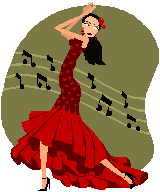Friday, September 05, 2008
What exactly is a "rhumba"?
The rhumba is a Cuban style of dance and music with strong African roots; it's very percussive and rhythmic, similar in many ways to a bossa nova. But the modern rhumba, the Americanized rhumba we recognize today, has undergone several radical changes from the African version brought to Cuba via the slave trade. The African rhumba, noted in the 16th century, is highly sexual and aggressive. The music is energetic, fast, staccato; it mimics the aggressiveness found within the dance. The staccato beats are very exaggerated, as exaggerated as the movements that go with them, and the instrumentation is mostly percussion.
The Cuban rhumba, first discovered in the 18th century, is far less aggressive than the African form. It's slightly slower and retains its intimacy without being quite as overtly sexual. The general consensus of the time was that the African rhumba, popular in its own right, was far too raunchy. It embodied a blatant sexuality that many people found to be indecent. The dance itself, however, had so many popular characteristics that to let the form die completely would be almost unthinkable. Instead, the African rhumba was toned down into a more subtle form and given some Latin elements particular to the area.
But that wasn't the last we'd see of the highly sexualized rhumba. Strangely enough, the form was given back some of its aggressiveness upon its arrival to the United States during Prohibition. This was a time when cabarets ruled the day and indecency among these circles (though certainly not in the mainstream) was almost encouraged. The rhumba became a common part of cabaret acts, though it was changed slightly to adapt to the stage. Of course, the cabaret rhumba still wasn't as overtly sexual as the African rhumba, but it fit somewhere neatly in between the African and Cuban versions.
Eventually the cabaret rhumba evolved into the modern rhumba, the ballroom dance still danced and played today. This version of the rhumba was toned way down from the African and cabaret versions (even from the Cuban rhumba) and danced slightly faster than usual. This version of the rhumba focused more on the romantic and intimate than the sexual and quickly became known as the dance of love.
Subscribe to:
Comments (Atom)


